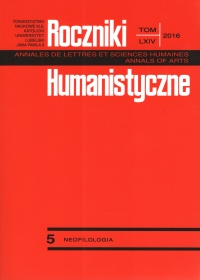Parallax: Looking at the Medieval through the Modern Lens
Abstract
The objective of the paper was to articulate the gap between the medieval manuscript and its modern editions. It emphasises the need to study medieval texts in their natural context, i.e. against the manuscript codex as only then do they speak in full voice. While the usefulness of electronic editions is indisputable, a linguist working with a modern edition of a medieval text must be aware of how far it departs from the text it intends to represent. Therefore, wherever possible, it is advisable to examine manuscript scans which are now widely accessible on internet sites of the libraries housing manuscript resources. It is of paramount importance not only as a way of verifying corpus examinations but also because manuscript examinations complement the findings based on electronic data by offering invaluable clues encoded in the materiality of the manuscript. This postulate is relevant both for historical linguistic analyses and translation studies, and is equally valid for literary studies.
References
Aresu, Francesco Marco. 2015. The Author as Scribe. Materiality and Textuality in the Trecento. Unpublished doctoral dissertation. Harvard University, Graduate School of Arts & Sciences. [online] https://dash.harvard.edu/handle/1/17467386
Bourgain, Pascale. 2015. The circulation of texts in manuscript culture. In Michael Johnston and Michael Van Dussen (eds.). The Medieval Manuscript Book Cultural Approaches. Cambridge: Cambridge University Press. 140–159.
Caie, Graham D. 2008. The manuscript experience: what medieval vernacular manuscripts tell us about authors and texts. In Graham D. Caie and Dennis Renevey (eds.). Medieval Texts in Context. London and New York: Routledge. 10–27.
Cerquiglini, Bernard. 1999. In Praise of the Variant. A Critical History of Philology. Baltimore: Johns Hopkins University Press.
Charzyńska-Wójcik, Magdalena. In press a. Między przekładem wiernym a parafrazą: wpływ czynników socjolingwistycznych na dobór techniki tłumacza.
Charzyńska-Wójcik, Magdalena. In press b. The anatomy of two medieval translations of the Psalter. In Translation and Meaning, edited by Łukasz Bogucki, Barbara Lewandowska-Tomaszczyk and Marcel Thelen. Frankfurt a. Main: Peter Lang.
Johnston, Michael, and Michael Van Dussen. 2015. “Introduction: manuscripts and cultural history.” In The Medieval Manuscript Book Cultural Approaches, edited by Michael Johnston and Michael Van Dussen (eds.), 1–16. Cambridge: Cambridge University Press.
Kenney, E.J. [1982] 2008. Books and readers in the Roman world. In E.J. Kenney and W. V. Clausen (eds.). The Cambridge History of Classical Literature. Volume 2. Latin Literature. Cambridge: Cambridge University Press. 3–32.
Kiss, Farkas Gábor, Eyal Poleg, Lucie Doležalová, and Rafał Wójcik. 2013. “Old light on new media: medieval practices in the digital age.” Digital Philology 2.1: 16–34.
Kwakkel, Erik. 2015. “Decoding the material book: cultural residue in medieval manuscripts. In The Medieval Manuscript Book Cultural Approaches, edited by Michael Johnston and Michael Van Dussen (eds.), 60–76. Cambridge: Cambridge University Press.
Long, Pamela O. 1991. “Invention, authorship, ‘intellectual property,’ and the origin of patents: notes towards a conceptual history.” Technology and Culture 32.4: 864–884.
Lowden, John. 2007. “The word made visible: the exterior of the early Christian book as visual argument.” In The Early Christian Book, edited by William E. Klingshirn and Linda Safran, 13–47. Washington, D.C: The Catholic University of America Press.
Lyons, Martyn. [2011] 2013. Books: A Living History. London: Thames and Hudson.
Mitchell, Bruce. 1980. “The dangers of disguise: Old English texts in modern punctuation.” The Review of English Studies. 31: 385–413.
Nichols, Stephen G. 1990. “Introduction: philology in a manuscript culture.” Speculum 65.1: 1–10.
Nichols, Stephen G. 2008. “Born medieval”: MSS. in the digital scriptorium. The Journal of Electronic Publishing 11.1. http://quod.lib.umich.edu/j/jep/3336451.0011.104?view=text; rgn=main
Nichols, Stephen G. 2015. “What is a manuscript culture? Technologies of the manuscript matrix.” In The Medieval Manuscript Book Cultural Approaches, edited by Michael Johnston and Michael Van Dussen, 34–59. Cambridge: Cambridge University Press.
Nichols, Stephen G. 2013. “What do we mean by variance today? Medieval manuscripts in the digital age.” http://www.academia.edu/5425936/What_Do_We_Mean_by_Variance_Today.
Parkes, Malcolm Beckwith. [1992] 2012. Pause and Effect: An Introduction to the History of Punctuation in the West. Farnham: Ashgate.
Poleg, Eyal. 2013. Approaching the Bible in Medieval England. Manchester and New York: Manchester University Press.
Saenger, Paul. 1997. Space Between Words: The Origins of Silent Reading. Stanford: Stanford University Press.
Taylor, Andrew. 2015. “Vernacular authorship and the control of manuscript production.” In The Medieval Manuscript Book Cultural Approaches, edited by Michael Johnston and Michael Van Dussen, 199–214. Cambridge: Cambridge University Press.
Voeste, Anja. 2012. “The emergence of suprasegmental spellings in German.” In Orthographies in Early Modern Europe, edited by Susan Baddeley and Anja Voeste, 167–192. Berlin and Boston: Walter de Gruyter.
Wakelin, Daniel. 2014. Scribal Correction and Literary Craft. English Manuscripts 1375–1510. Cambridge: Cambridge University Press.
Copyright (c) 2016 Roczniki Humanistyczne

This work is licensed under a Creative Commons Attribution-NonCommercial-NoDerivatives 4.0 International License.





